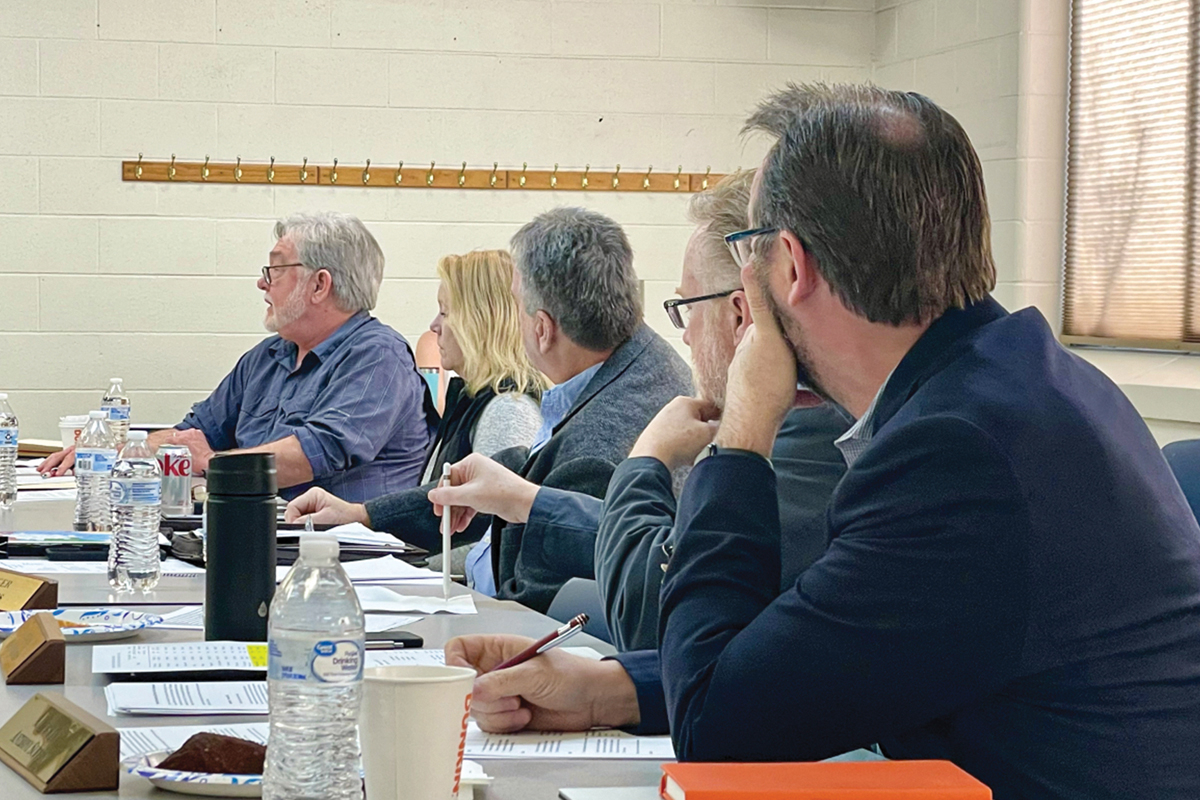Mounting capital needs put tax increase on the table in Waynesville
 Waynesville’s Town Council has some tough decisions ahead. Cory Vaillancourt photo
Waynesville’s Town Council has some tough decisions ahead. Cory Vaillancourt photo
Waynesville’s town government has kept taxes as low as possible for as long as possible, but is quickly finding truth in the adage, “It’s easier to keep up than to catch up” — over the years, capital spending hasn’t kept up with the town’s needs, and now taxpayers may be looking at a costly game of catch-up.
“I’m loathe to raise taxes unless there’s some dramatic need like what we did in 2016 when we hired the eight new firefighters,” said Jon Feichter, a member of Waynesville’s Town Council, at the outset of an April 17 budget meeting.
Back in 2016, Waynesville raised its property tax rate by four cents to pay for additional firefighters to meet federal guidelines for staffing. It was the town’s last substantial tax increase, and like Haywood County’s 2023 tax increase to fund additional school resource officers, it garnered nary a whimper of opposition due to the public-safety nature of the spending.
The ongoing countywide property revaluation, expected to show double-digit percentages of growth similar to the last one, won’t be reflected on tax bills until next budget year, so council will have the option of kicking the can down the road again, one more time, or tightening up spending, raising taxes and moving forward.
On the bright side, the town expects a $516,000 boost in revenue, including $211,000 from natural growth and property development over the past year, a $100,000 increase in investment income, a projected 3% increase in sales tax collections worth $135,000, a $50,000 increase in distributions from the Alcoholic Beverage Control Board and $20,000 in additional revenue from the town’s recreation services.
The town was also able to negotiate a 0% increase in its health care coverage, and tax collection rates remain incredibly high, but none of those factors alone will be enough to solve all of Waynesville’s issues.
Related Items
To that end, town staff presented three budget options to Council during the workshop — lean, leaner and leanest.
The leanest option projects general fund revenues of $18.4 million with no property tax increase, no sewer and water rate increase and no increase in fire taxes for outside districts.
Under this option, that $516,000 in new revenue would be completely eaten up by increasing costs for gas, tires and electricity, a 1% cost of living adjustment for town workers totaling $103,000, career track payments for employees and police totaling $248,000 and a 1% increase in contributions to the state’s employee retirement system. The only general fund capital spending proposed would be $155,000 for new meter readers, a timeclock system for the payroll department, an electric vehicle and charger for the police department and an electric mower for the town’s cemeteries.
A 7% rate increase is proposed for the town’s electric customers, which would eventually be offset by revenue from new customers plugging in at the new residential developments within the town’s service area.
The second, “leaner” option projects general fund revenues of $18.6 million and includes a one-cent property tax increase per $100 in assessed value. At current valuations, each one-cent tax increase generates roughly $165,000 in revenue. Adding that increase to the $516,000 in new revenue gives the town $681,000. This option includes no fire, water or sewer rate increases, maintains the 7% electric rate increase as well as the COLA, career track and retirement contributions, and proposes a new stormwater management fee.
Assistant Town Manager Jesse Fowler constructed and presented a complicated and elaborate tier system for residential and commercial property owners that would be used to buy, maintain and construct various apparatus for the town’s stormwater management system and help the town comply with an unfunded mandate from the state to prove it is spending money on the elimination of inflow and infiltration into the town’s wastewater treatment system.
Fowler’s fee structure was devised to ensure that properties having the greatest impact on the stormwater system — very large properties or properties with lots of impervious surfaces — pay their fair share.
Right now, the biggest residential contributors to stormwater runoff would pay about $7.20 a month, while the largest commercial contributors would pay about $12 a month. The vast majority of residential customers would end up paying about $1.20 a month, with the smallest commercial customers paying $2.40 a month, although Council members aren’t yet firm on where they want those rates to be.
“It’s not a tax,” Fowler said. “We’re charging people for a service that’s incredibly expensive.”
As proposed, the stormwater fee would go into effect in September with bills due Jan. 1, 2025 and raise about $150,000 in its first nine months of operation, which would instantly free up $75,000 in general fund revenue currently allocated to pay for maintenance and improvements to the system. The next year, the stormwater fee’s first full year, it’s expected to gross around $200,000.
Between the stormwater fee and the one-cent tax increase, the revenue generated would allow the town to hire a planner to manage the stormwater program and would also allow the town to purchase all of the capital items in the leanest option, plus pay for $66,000 in police requests — including new ballistic armor — along with a $100,000 leaf collector, an electric vehicle for development services and some, but not all, cardio equipment requested by the town’s recreation department.
The second option also includes a new position, environmental sustainability director, with the town’s four funds (general, water, sewer and electric) all splitting the cost. Although technically an outlay, the director would be responsible for helping the town save money by ferreting out wasteful energy practices.
The third option, the “lean” option, proposes a two-cent property tax increase that would generate approximately $330,000 in new revenue on top of the $516,000 that will be realized regardless of which option Council selects. Like the “leaner” and “leanest” options, no increase in fire, water or sewer rates is expected. The electric rate increase would survive, however the stormwater fee would not, resulting in general fund projections of $18.7 million in revenue.
This option, like the others, includes the 1% COLA and the career track and retirement contributions. The only real change in expenditures under this option would be reverting the stormwater spending to the general fund instead of a new stormwater fund, and spending $101,000 to purchase all of the cardio equipment requested by the recreation department.
Council members briefly haggled over the three options, trading horses and attempting to find consensus, but Council Member Anthony Sutton made quite a splash by presenting his own fourth option, one he jokingly called the “platinum plan.”
“I think a 1% cost-of-living increase is kind of a slap in the face to our employees,” Sutton said, noting that for someone making $50,000 a year, the 1% raise would be less than $10 a week before income taxes.
Sutton’s plan consists of a two-cent increase, plus the stormwater fee, and an increase in the COLA to 2%. He called the 2% COLA his “line in the sand.” Council Member Julia Freeman appeared to agree with Sutton on the 2% COLA but offered her own twist on the town’s budget priorities.
“I want to do [all] that with no tax increase,” Freeman said.
In recent years, the town has redoubled its efforts to take good care of its employees, as have most local governments in the county. After years of sluggish pay increases, the call of higher-paying jobs from across the region became too much to ignore for most municipal employees, resulting in turnover that costs more than keeping an employee working with steady raises.
One thought on how to reduce expenses would be to require municipal retirees to contribute 35% to the cost of their coverage, instead of the current 25%. The town could also eliminate health care coverage in retirement for new employees, or cap payments once retirees have been gone for 15 years. The projected savings wasn’t discussed at the meeting, and the idea didn’t seem to gain much traction, leaving Council to deliberate on the four options before them.
While there seemed to be consensus on the 2% COLA and the stormwater fee, most Council members were guarded with their opinions, prompting Sutton to reiterate his desire to raise taxes to pay for critical town needs.
Sutton noted that he, along with Julia Freeman, are both up for reelection next year — the result of the town’s switch to staggered terms. Previously, all four Council members plus the mayor would be up for election every four years, but now, Waynesville will fall into line with other Haywood County municipalities, electing two Council members every four years. As the lowest vote-getters in the November 2023 election, Sutton and Freeman only won two-year terms.
“I’m willing to lose an election to get what our people need,” Sutton said, reiterating the town’s employee-centric budgeting trends.
For pretty much his entire tenure on Waynesville’s governing board, Sutton has pushed the town to take a more aggressive stance in planning for predictable, ongoing capital needs — things like police cars, fire trucks and the like. At one point, Council even discussed the possibility of a bond issue to clear out the backlog, even though that would result in a regular long-term loan payment in the face of annual capital spending.
Town Manager Rob Hites remarked that when he calculated the cost of fulfilling all extant department budget requests a few years ago, the cost would be equivalent to a 10-cent increase on the property tax rate, or more than $1.5 million.
Chief David Adams said he’d be willing to give up some of his department’s equipment requests — Sutton said he wouldn’t allow the police department to go without new body armor — in exchange for a 3% COLA and so other departments could get some of their needs fulfilled. At the top of Adams’ cut list was the proposed electric vehicle. Assistant Chief Brandon Gilmore said he’d talked with other police departments about their electric vehicles, and reported that they simply can’t withstand the rigors of police use at the moment.
Elizabeth Teague said the same about a proposed electric vehicle for the planning department — it’s not completely necessary.
Fire Chief Joey Webb said his department has huge needs, including a new fire truck that wouldn’t be delivered for three years, well past his imminent retirement, even if the truck was ordered immediately.
The meeting ended with Council asking department heads to prioritize their budget requests and submit them to Hites.
Per statute, municipal budgets must be passed no later than July 1 each year, so Council still has some time to review the requests and make final budget decisions.













